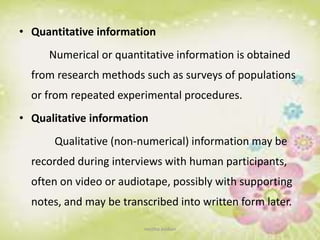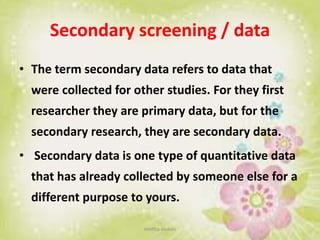Data collection
- 1. Data collection in research neethu asokan
- 2. What is data ? • Fact & statistic collected together for reference or analysis • research data is defined as recorder factual material commonly retained by and accepted in the scientific community as necessary to validate research findings. neethu asokan
- 3. Data collection • Data collection is a systematic process of collecting information about objects of study (people, objects, phenomena for instance) in order to test the hypothesis or answer the research questions of the study. neethu asokan
- 4. Purposes • Research design • Sampling design • Data gathering and /or field work techniques • Data processing and analysis neethu asokan
- 5. Research design • A detailed outline of how an investigation will take place. A research design will typically include how data is to be collected, what instruments will be employed, how the instrument will be used and the intended means for analyzing data collected. neethu asokan
- 6. Sample design • The sample design encompasses all aspects of how to group units on the frame, determine the sample size, allocate the sample to the various classification of frame units, and finally, select the sample. • A process used in statistical analysis in which a predetermined number of observation will be taken from a larger population. neethu asokan
- 7. Types of data collection • A common classification is based upon who collected the data. • Primary data: the primary data are those which are collected afresh and for the first time. • Secondary data: on the other hand, are those which have already been collected by someone else and which have already been passed through the statistical process. neethu asokan
- 9. Primary screening/ data • Primary data are information collected by a researcher specifically for a research assignment. • Primary data are original in nature and directly related to the issue or problem and current data. • Primary data are the data which the researcher collects through various methods like interviews, surveys, questionnaires etc. neethu asokan
- 10. • Quantitative information Numerical or quantitative information is obtained from research methods such as surveys of populations or from repeated experimental procedures. • Qualitative information Qualitative (non-numerical) information may be recorded during interviews with human participants, often on video or audiotape, possibly with supporting notes, and may be transcribed into written form later. neethu asokan
- 11. There are many methods of collecting primary data. The main methods include: • questionnaires • interviews • focus group interviews • observation • case-studies neethu asokan
- 12. Questionnaires • Questionnaire is a set of questions has been prepared to ask a number of questions and collect answers from respondents relating to the research topic. • A number of questions usually in printed or electronic form are to be answered by the individuals. The forms often have blank spaces in which the answers can be written. • A questionnaire is a series of questions asked to individuals to obtain statistically useful information about a given topic. neethu asokan
- 13. Interview • In this method the interviewer personally meets the informants and asks necessary questions to them regarding the subject of enquiry. • Usually a set of questions or a questionnaire is carried by him and questions are also asked according to that. • The interviewer efficiently collects the data from the informants by cross examining them. • Two types of interview are their: Personal interview. Telephone interview. neethu asokan
- 14. Personal and telephone interview • Personal interview method requires adperson know as the interviewer asking question generally in a face to face contact to the other persons. This sort of interview may be in the form if direct personal investigation or it may be indirect oral investigation. • Telephone interview method is collecting information consists in contacting respondents on telephone itself neethu asokan
- 15. Focus group • A focus group is a moderator keeps a small and homogeneous group, usually less than 15 people, focused on the discussion of a research topic or issue. • Focus group sessions may be recorded using audio and/or videotapes. • The method is useful for exploring ideas and obtaining in-depth information about how people think about an issue. neethu asokan
- 16. Observation • Observation, particularly participant observation, has been used in a variety of disciplines as a tool for collecting data about people, processes, and cultures in qualitative research. • Observations enable the researcher to describe existing situations using the five senses, providing a "written photograph" of the situation under study neethu asokan
- 17. Case study • The case study method is a technique by which individual factor whether it be an institution or just an episode in the life of an individual or group is analysed in its relationship to any other in the group. • It is a very important form of qualitative analysis and involves a carful and complete observation of a social unit a person, a family, an institution, a cultural group or even the entire community. neethu asokan
- 18. • Survey is used to collect quantitative information about items in a population. • Surveys are used in different areas for collecting the data even in public and private sectors. • A survey may be conducted in the field by the researcher. neethu asokan
- 19. Some Advantages of using Primary data: • The investigator collects data specific to the problem under study. • There is no doubt about the quality of the data collected (for the investigator). • If required, it may be possible to obtain additional data during the study period. neethu asokan
- 20. Some disadvantages of using primary data • The investigator has to contend with all the hassles of data collection. • Ensuring the data collected is of a high standard • Cost of obtaining the data is often the ajor expense in studies. neethu asokan
- 21. Secondary screening / data • The term secondary data refers to data that were collected for other studies. For they first researcher they are primary data, but for the secondary research, they are secondary data. • Secondary data is one type of quantitative data that has already collected by someone else for a different purpose to yours. neethu asokan
- 22. Advantages of using Secondary data: • The data’s already there- no hassles of data collection • It is less expensive and faster • The investigator is not personally responsible for the quality of data neethu asokan
- 23. Disadvantages of using Secondary data: • Not easily available • Not adequate • May not meet the needs of researcher • Outdated information • Variation in definition • Inaccurate or bias neethu asokan
- 24. neethu asokan























